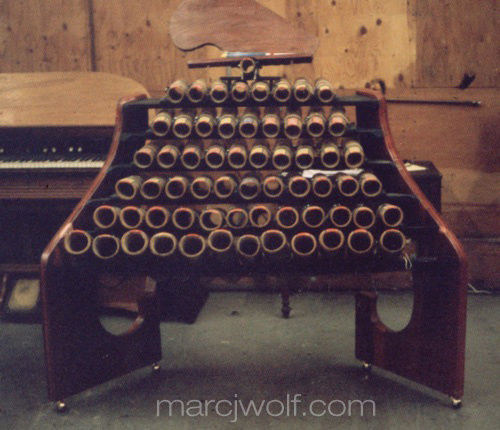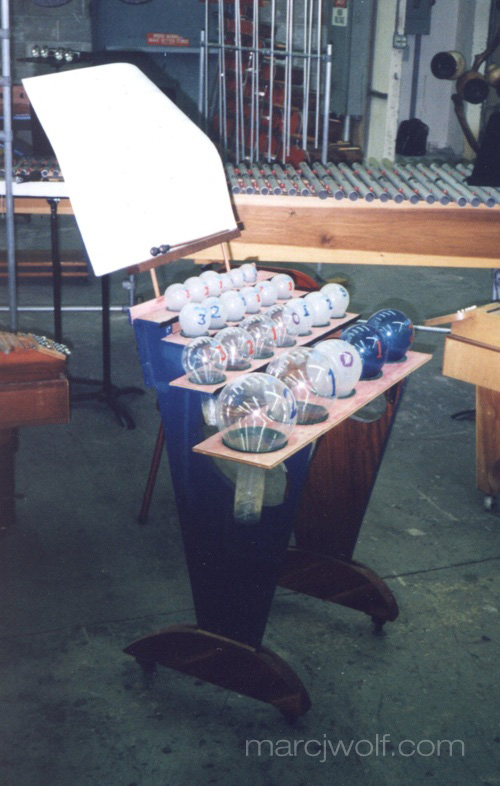Harry Partch: America's first Microtonal Composer
Part 3: The Instruments
(The following are descriptions of some of Harry Partch’s instruments. For a more detailed and complete survey, see Partch’s book Genesis of a Music. All quotes that follow are from chapter 12 & 13 of Genesis of a Music).
Chromelodeon I
The Chromelodeon is used in most of Partch’s works. It is an old Harmonium that has had all of its reeds removed and retuned to Partch’s original 43-degree monophonic system. The keyboard is only changed in the fact that the keys are painted and the ratios representing their pitch is indicated on the key.
“A very valuable adjunct of nearly all harmoniums are the knee swells. In U.S. Highball, the pulsing, rhythmic use of the right swell helps materially in pushing that freight train to Chicago.”
Kithara
Partch’s Kitharas are some of his most beautiful instruments. It is played either with the flesh of the hand or a special ring pick that Partch devised for the purpose. At the sides are sets of strings with movable glass Pyrex rods that act as movable bridges for glissandi or to access any higher tonality desired. These are used prominently in the majority of Partch’s works.
Surrogate Kithara
was created to ease the burden of the Kithara part in the work Castor and Pollux, the part being broken up between the two instruments. It is smaller and can be played sitting down. This position allows for more complex use of the rod and for bending techniques similar to a Koto to be incorporated. It was used in the Dances, The Bewitched, Daphne on the Dunes among others.
The Harmonic Canon
is relatively simple in its conception, a rectangular box with 44 strings attached at one end to pegs, and the other to guitar tuners. The strings rest on various movable bridges, allow for great variety in the tuning. It can be played with mallets, picks either plucking individual strings, or strumming glissandos, or with fingers. The original Harmonic canon had 2 sets of 44 strings and a 14” Pyrex rod under the bottom set for further controlling intonation. “The harmonic canon idea (harmonic law) is that of a glorified multiple monochord, and once the design and placement of bridges and the tuning of strings is decided, at least half of the creative concept is established. And this half may be just as imaginative as the writing of actual notes.”
The Quadrangularis Reversum
is a later development of Partch’s Diamond Marimba, an instrument that illustrated his theory in its design. “This instrument is the theoretical Tonality Diamond brought to practical tonal life.” The diamond has at its lower point the 1/1 ratio, and extends to the right with Otonalities, and to the left with Utonalities. (the overtone series, Otonality, and its inverse Utonality).
The Bass Marimba
consists of 11 vertical-grain , Sitka-spruce blocks, the longest 53” and the shortest 27”. The resonators are the lower ends of organ pipes with plungers at the closed ends to allow adjustments in the volume of air. Four kinds of mallets are used, as well as the tips of fingers. Occasionally large sheepskin-covered mallets are played directly over the resonators for maximum resonance. Because of the height of the resonators required for good low-end response, the player must stand on a riser to play.
The Marimba Eroica
This is one of Partch’s most interesting instruments, a 4 note marimba which produces very low tones. Each note is roughly the size of an upright piano, the resonators being large empty plywood boxes and the block a long redwood timber suspended on foam. The mallets are very large and weigh about 4 pounds each.
The Boos (Bamboo Marimba)
are constructed usually of bamboo with tuned tongues, though the one currently used is made from PVC tubing, and is less prone to tuning fluctuations from the material. The cylinders are laid out in 6 rows, in descending order of size from the bottom to top and mallets are usually used. Boos give “dry sounds, sharp in character and short in duration.”
The Cloud Chamber Bowls
are fourteen sections of 12 gallon Pyrex carboys, suspended from a redwood frame in seven vertical lines by rope and s hooks. The original carboys used were found at the Radiation Laboratory glass shop at the University of California, Berkeley in 1950. “I discovered that a very beautiful but complex sound could be produced if the center of a section was suspended by one hand, so that the edge was free, while the other hand struck with fingertips on the edge. As long as my experiments went on, I undoubtedly deprived various faculty wives of many punch and fish bowls.”
The Mazda Marimba
is a delicate and soft instrument that is composed of various sized lightbulbs mounted in a frame and resting on foam. “The delightful sounds of the instrument resemble, more than anything else, the bubbling of a coffee percolator.”
Throughout his life, Harry Partch was faced with resistance to his revolutionary and controversial ideas. His theories, writings, instruments, music and life can be seen as one unified act of transcendence, subversion and defiance. His struggle was nothing less than the millennia old fight against the expropriation of man through the development of autonomous technology and the destruction of nature. Partch ruled the technology required to complete his creative vision, a vital art, which never compromised its core of primitive sexual impulse, subversive to all systems of indoctrination and those that seek to regiment or commodify the creative spirit.











